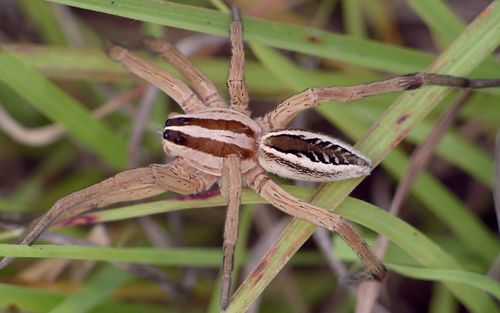by Valerie
April, 2010Rabid Wolf Spider
Wolf spiders tend to look scary. Many people are frightened by spiders, and one that runs around very quickly, is rather large, and has a name like rabid wolf spider (Rabidosa rabida) just encourages that response. I admit that I am not beyond a panic response when one of these crawls onto my foot. However, the handsome pattern on this species gives it an elegance that cannot be denied. As a family (Lycosidae), wolf spiders are readily identifiable. Recognizing their genus or species, though, can be a challenge, as many have only vague markings. The rabid wolf spider is one of the few that is so distinctive that it is easy to get a specific identification, even at a glance. It is one of the largest spiders in our area, with females reaching an inch in length. The long legs make them appear MUCH bigger, especially when viewed close up. Both males and females have the clear brown markings, and the light colored chevrons within the abdominal stripe help separate this species from a similar one in our area (Rabidosa punctulata) which has a solid brown stripe. Male rabid wolf spiders have another distinguishing characteristic when they are fully mature: their front pair of legs are black. This spider is often found in yards and gardens, preferring grassy areas where it is a well-camouflaged and active nocturnal hunter. It is usually seen when it is scared out of hiding during the day. Although no wolf spiders are considered to be poisonous, all of these animals do have venom and many have large enough fangs to puncture human flesh, so they should be handled with care. I have been bitten a couple of times by wolf spiders while working in the garden and wearing shorts. Spiders do not take kindly to somebody kneeling on them and will defend themselves. The bites consist of a pair of stab wounds, unequal in size (probably because the fangs do not enter equally and so do not deliver exactly the same amount of venom), and feel like a bad wasp sting. Although individual reactions will vary, for me spider bite reactions last for several days, itching badly off and on, with periods in between when the symptoms go away. Female wolf spiders are very doting mothers, carrying their egg sacs around under their abdomen. When the spiderlings hatch out, they ride about on the mother's back for a short time. Eventually, they molt, become too big for this hitchhiking and scatter to fend for themselves. Because they actively pursue prey, rabid wolf spiders do not make a web snare. They do use silk to cover their eggs though. As with all predators, they will catch and eat anything they can, including each other. I once found a female with a full-grown male in her jaws, but their usual prey probably consists of insects such as crickets and roaches. |